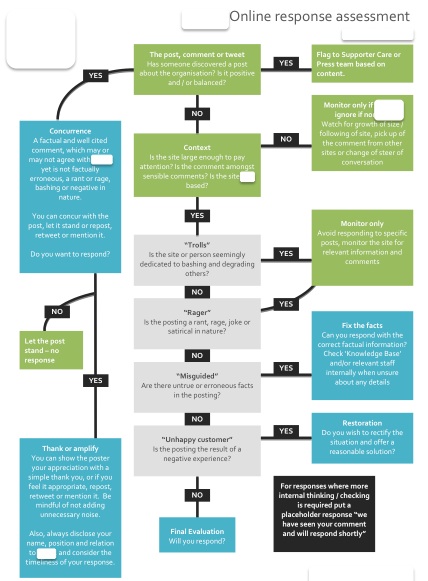
Social media moderation guidelines empower community managers to respond to online comments and posts quickly and effectively.
I’ve talked a lot about the importance of content marketing and content planning for social media – but what I’ve never spoken about in much detail is social media moderation. Many businesses have a social media policy which is a fairly lengthy and non-user friendly document that dictates what you cannot do but isn’t very helpful in giving guidance on what you can do. Social media moderation guidelines, sometimes called online response assessment structures, are important for a social media community manager to be empowered to take the action required, quickly and effectively.

Community Managers are empowered to respond to public posts quickly and effectively when armed with an online response assessment structure.
Social media response assessment structures help social media moderators clearly define if a comment or post requires a response and what type of response should be considered. In my opinion, social media community managers should be senior staff who have experience dealing with customer and public enquiries as well as fielding statements from media or other public entities. A social media community manager needs to be empowered to make fast decisions and respond to posts in the public space, swiftly and definitively where needed.
Social media moderation is required for every business and for some businesses who are particularly sensitive or risk averse, online response assessment structures provide the necessary process and risk management steps needed to accept that brand even being allowed to participate in the very public, social media space. Social media moderation guidelines are also important to help community managers and individuals deal with negative or abusive trolls in the social media space. In recent months in Australia we have seen many public offensive comments made towards politicians, celebrities, sports starts and individuals. A social media online response assessment structure will aid these parties in knowing how to deal with and respond to such negative sentiment online.
Unfortunately being in the social media space means that brands and individuals may face criticism and sometimes abuse. This is an awful side effect of what has by and large been a popular and positive channel for communication and collaboration between individuals and brands. Having social media moderation guidelines and an online response assessment structure will help your staff deal with these negative comments when they do arise.
Social media does open businesses up to some risk and many brands have chosen not to participate in this marketing space because of the possibility of negative sentiment. However, I believe this is a mistake. The simplest argument put forward to such a business who has chosen not to engage in social media, is that “people will be talking about your brand anyway, don’t you want to be part of the conversation?” If that isn’t enough to convince your business to dip their toe into the social media space, we could try “Your customers are in this space and they want to talk to you here, where it is convenient and where they feel that their voice is equal to that of your business” If your business truly cares for its customers, is it not important to listen to their wants and needs and throw caution to the wind and engage with them in a public, two-way conversation? Like so many other businesses have done – and are still standing.
Unfortunately I am a cynic and I believe that the businesses who choose not to go into social media, do not put their customers first. These businesses are proving that they care more about their internal policies and ego, that they put their perceived brand reputation ahead of their actual brand reputation and do not want to allow their customers a voice.
Of course this is overly simplistic view of businesses who have not entered the social space. I am fully aware that many believe they simply do not have the resources or that they do not understand this space and therefore will not go forth. If your business falls into this category, I challenge you to start listening. Sign up to social networking websites as an individuals and subscribe/ like/ follow your competitors or the brands that you personally love and see how they behave in the social media space. And perhaps put forward an argument to your management to consider creating some social media guidelines and get involved.

Trackbacks/Pingbacks